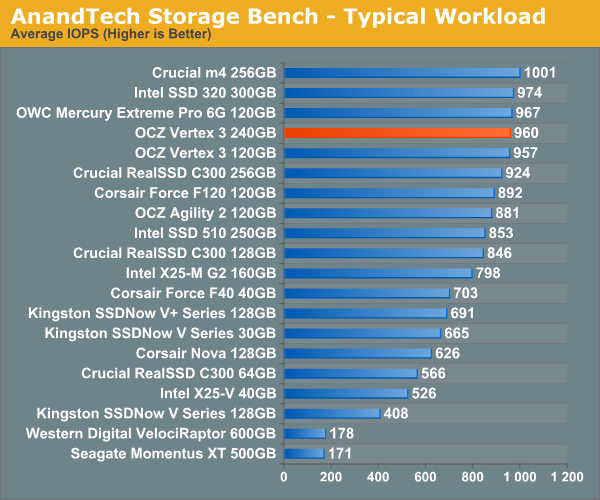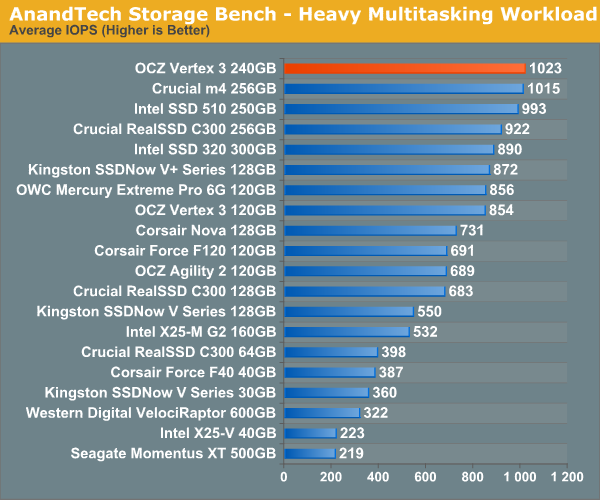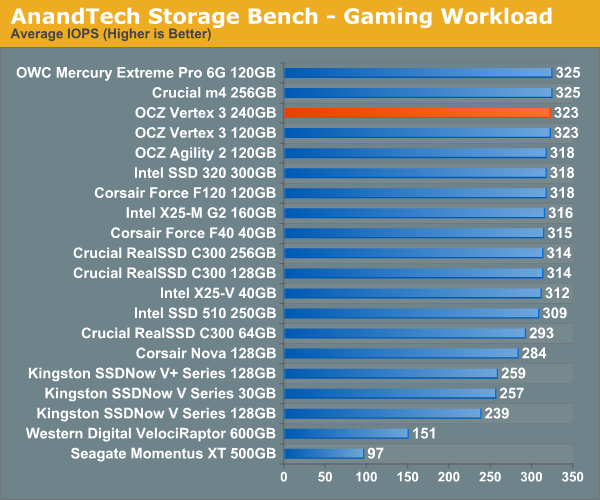OCZ Vertex 3 (240GB) Review
by Anand Lal Shimpi on May 6, 2011 1:50 AM ESTAnandTech Storage Bench 2010
To keep things consistent we've also included our older Storage Bench. Note that the old storage test system doesn't have a SATA 6Gbps controller, so we only have one result for the 6Gbps drives.
The first in our benchmark suite is a light/typical usage case. The Windows 7 system is loaded with Firefox, Office 2007 and Adobe Reader among other applications. With Firefox we browse web pages like Facebook, AnandTech, Digg and other sites. Outlook is also running and we use it to check emails, create and send a message with a PDF attachment. Adobe Reader is used to view some PDFs. Excel 2007 is used to create a spreadsheet, graphs and save the document. The same goes for Word 2007. We open and step through a presentation in PowerPoint 2007 received as an email attachment before saving it to the desktop. Finally we watch a bit of a Firefly episode in Windows Media Player 11.
There’s some level of multitasking going on here but it’s not unreasonable by any means. Generally the application tasks proceed linearly, with the exception of things like web browsing which may happen in between one of the other tasks.
The recording is played back on all of our drives here today. Remember that we’re isolating disk performance, all we’re doing is playing back every single disk access that happened in that ~5 minute period of usage. The light workload is composed of 37,501 reads and 20,268 writes. Over 30% of the IOs are 4KB, 11% are 16KB, 22% are 32KB and approximately 13% are 64KB in size. Less than 30% of the operations are absolutely sequential in nature. Average queue depth is 6.09 IOs.
The performance results are reported in average I/O Operations per Second (IOPS):

If there’s a light usage case there’s bound to be a heavy one. In this test we have Microsoft Security Essentials running in the background with real time virus scanning enabled. We also perform a quick scan in the middle of the test. Firefox, Outlook, Excel, Word and Powerpoint are all used the same as they were in the light test. We add Photoshop CS4 to the mix, opening a bunch of 12MP images, editing them, then saving them as highly compressed JPGs for web publishing. Windows 7’s picture viewer is used to view a bunch of pictures on the hard drive. We use 7-zip to create and extract .7z archives. Downloading is also prominently featured in our heavy test; we download large files from the Internet during portions of the benchmark, as well as use uTorrent to grab a couple of torrents. Some of the applications in use are installed during the benchmark, Windows updates are also installed. Towards the end of the test we launch World of Warcraft, play for a few minutes, then delete the folder. This test also takes into account all of the disk accesses that happen while the OS is booting.
The benchmark is 22 minutes long and it consists of 128,895 read operations and 72,411 write operations. Roughly 44% of all IOs were sequential. Approximately 30% of all accesses were 4KB in size, 12% were 16KB in size, 14% were 32KB and 20% were 64KB. Average queue depth was 3.59.

The gaming workload is made up of 75,206 read operations and only 4,592 write operations. Only 20% of the accesses are 4KB in size, nearly 40% are 64KB and 20% are 32KB. A whopping 69% of the IOs are sequential, meaning this is predominantly a sequential read benchmark. The average queue depth is 7.76 IOs.











90 Comments
View All Comments
dagamer34 - Friday, May 6, 2011 - link
Yeah, I kinda addressed that with the fact that "should you pay $100 to boot Windows in 9 seconds instead of 14". I'm arguing the practical purpose of it, not the theoretical one.People don't buy SSDs for faster boot times because that's something you do only once a day. They buy them to avoid the silly 15 sec Photoshop load time and increase the general responsiveness of their system. Once you go from 6.8ms latency to 0.1ms latency, I don't see how you improve that further.
Omid.M - Friday, May 6, 2011 - link
I've noticed every time you cover SSDs that you have a recommendation for OS X that's generally different from your conclusion in the article.Is that the case here as well?
How would you rank the top 3 SSDs for Macs, if each is from a different vendor? From a reliability standpoint, as I don't think the difference in speed is noticeable to the end user unless performing specific tasks:
Intel 510 (or 320)
Vertex 3
Crucial C300
What do you think, Anand?
@moids
purrcatian - Friday, May 6, 2011 - link
Macs don't support TRIM. There aren't too many high performance SSDs with which you can get away with using them without TRIM and expect long term speed. SandForce controllers have always been good at working without TRIM, so the Vertex 3 would likely be your best bet.The Marvel controllers in the Crucial C300 and Intel 510 are know for not working too well without TRIM, so they wouldn't be a good choice for a Mac.
Anand Lal Shimpi - Friday, May 6, 2011 - link
If you've got a Mac with a 6Gbps interface, then the Vertex 3 240GB is a solid recommendation. Note that some users have had issues with the 2011 MBPs and Vertex 3s but personally I've lucked out. I suspect there may be some odd issues with Apple's ribbon cable for the 6Gbps bay.If you're running a 3Gbps Mac then I'd say SSD 510 or 320. Still waiting to see how the smaller capacity drives perform though.
Take care,
Anand
Omid.M - Friday, May 6, 2011 - link
Anand,And I bet Apple has been silent about the ribbon cable theory?
I would hope a company with so many engineering resources (and so vertically integrated) could quickly look into something like that and rule it out.
@moids
darwinosx - Friday, May 6, 2011 - link
I know why wouldn't Apple drop everything and use all their resources to investigate every theory about their hardware...darwinosx - Friday, May 6, 2011 - link
Many, many Mac users are having issues with the Intel 510 but have seen no issues with the 320.kasakka - Friday, May 6, 2011 - link
OSX does support TRIM now, but it's only enabled for Apple branded drives. There's a hack that lets you enable it for all drives and at least on my X25-M it shows as enabled but can't say anything about performance - even without it the drive has been very fast for the year I've had it.I guess that OSX Lion will officially support TRIM for all drives.
Omid.M - Friday, May 6, 2011 - link
Thanks for the reply.I understand TRIM is not supported natively for non-Apple SSDs, but I also have read about the kext hack that enables TRIM for 3rd party drives. Of course, my question implies that I would enable this hack to try it out.
From what I've read on MacRumors forums (and I believe AT forums), people are having better luck with Intel 320 than the Vertex 3. The speed difference can't be that noticeable in every day use (save for niche situations?), so I'd take reliability over a marginal increase in speed, assuming TRIM would be enabled via the hack.
I think I would take the Intel 320 300 GB (280 GB usable) over the Vertex 3 240 GB.
I'd love to see a comparison of error rates (RMA rates, I guess) between the manufacturers for those specific drive capacities.
Maybe AFTER OCZ sends Anand the last batch of requested SSDs for testing? :)
@moids
darwinosx - Friday, May 6, 2011 - link
But they will in a month or so when Tiger comes out. Or you can download TRIM functionality right now.